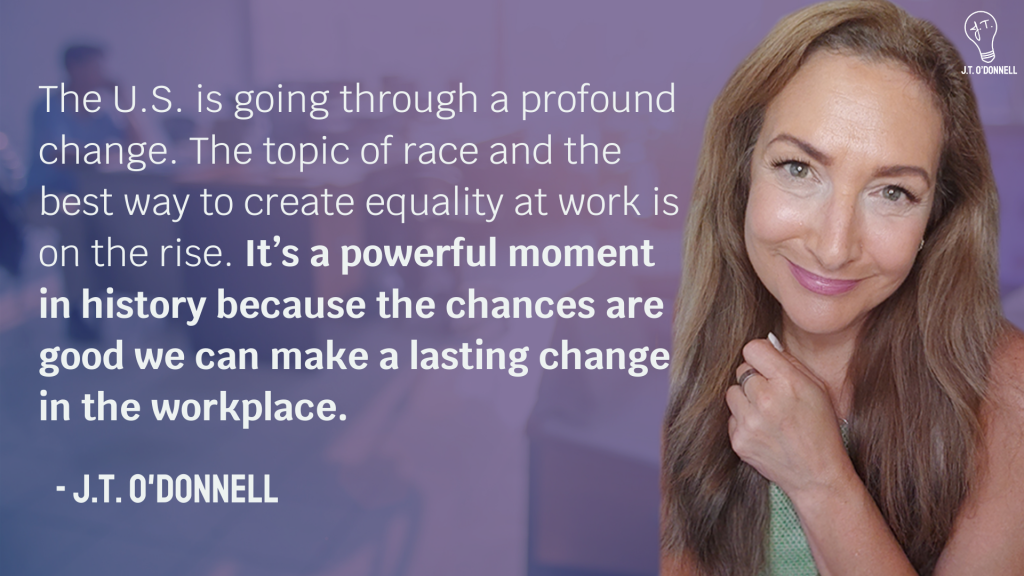The U.S. is going through a profound change. The topic of race and the best way to create equality at work is on the rise. It’s a powerful moment in history because the chances are good we can make a lasting change in the workplace.
However, given the intensity of the topic, it can be easy for managers to want to push off these discussions, hoping things will die down or take care of themselves. However, good leaders know that these difficult conversations are EXACTLY what’s needed to make progress.
I’ve been lucky enough to have diversity, inclusion & belonging expert, Stacey Lewis, join me on several episodes of JT Talks Jobs to discuss Race in the Workplace. Lewis is the founder of HR Interrupted, an organization focused on interrupting the historical ideologies/practices through inspiration & insight.
Lewis is an extremely open and genuine person and has offered great insight about how to identify and address these issues in the workplace. Through our discussions, I’ve identified some best practices leaders can use right now to have a meaningful conversation about race in the workplace.
1. Start in “listen-only” mode
Think about your time in school and the process of learning. While it’s nice to know the answers and participate in the classroom discussions, there comes a time before you reach that point where you just need to sit, listen to the teacher, and let the information sink in. Once you take the time to do that, there will be plenty of time for questions and additional discussion.
You should take that same approach with discussions about race and inequality in the workplace. Invite an expert to discuss the issues and encourage everyone to just listen. There will be plenty of time for questions and discussion later.
2. Use curiosity to explore angry or defensive feelings
One topic that we discussed in-depth on JT Talks Jobs was microaggressions.
The simple definition that Lewis gives for microaggressions is “brief, everyday exchanges that send denigrating messages to a certain individual because of who they are.”
Some subtle examples of microaggressions that you may hear in the workplace include:
- “I don’t see color when I see you.”
- “You’re really pretty for a dark skin person.”
- “Why do you sound white?”
If you’re on the receiving end of some of these microaggressions, they can slowly add up and eat away at you. The best way to address this, according to Lewis, is by using intellectual curiosity and asking the person “What’s the foundation of your statement?”
That way you’re opening the door to have a conversation, where you can then explain why such comments are hurtful.
This allows the victim of the microaggression to share their experience with the colleague, while giving the colleague an opportunity to listen and learn.
3. Embrace the reality that you will make mistakes
You don’t know what you don’t know!
For many people having conversations about race and inequality is new territory, and whenever you tackle something new, there’s always the chance that mistakes will be made. That’s OK!
As long as you’re willing to learn from your mistakes, and commit to making the necessary changes, you can come out better for it.
4. Understand that your privilege doesn’t make you a bad person
Some people don’t fully understand the definition of white privilege, and sometimes take it as a personal attack. But, that’s not the case at all.
As Lewis explains, white privilege means that while you probably have had some difficult times in your life, “your race, being white, probably was not a contributing factor to those difficulties.”
White privilege is not a personal attack, it’s just an acknowledgment that your life experiences are different than others, and for some race plays a larger role in their life experiences.
Once everyone realizes this, it opens the door for some important conversations.
5. Study the terms and language associated with workplace racism
Put some time aside to do your own research on issues of race and inequality in the workplace. Take note of some of the things that stand out to you, and write down any ideas that you have.
It’s particularly important to familiarize yourself with the terms and language associated with workplace racism. Looking for a place to start? Lewis discusses some of these terms in our Race in the Workplace episodes of JT Talks Jobs, and you can learn more on the HR Interrupted website.
Sometimes the toughest part in having these tough conversations is finding a starting point. I hope the above advice is helpful in getting you to that starting point. The sooner you engage in meaningful conversations around race and inequality at work, the sooner you can help yourself and those around you find ways to take actions that improve the situation for everyone.
Here’s Another Opportunity To Educate Yourself
I will be speaking with Lewis again on Wednesday, Sept. 16 at 12 p.m. (EST). We will be talking about biases during the hiring process.
In addition to gaining valuable insights from our guest, there will also be an open dialogue with the opportunity to ask both of us some questions at the end – something I truly hope you do!
You’ll be able to check out the livestream here.
All of us at Work It Daily want to be more informed about the struggles Black Americans and other minorities face on a daily basis, so we can better help those communities with their careers. We realize that what we do best as a company is educating and providing useful resources to those who need them, which is why we continue to have these discussions with Lewis.
Some additional FREE resources include:


